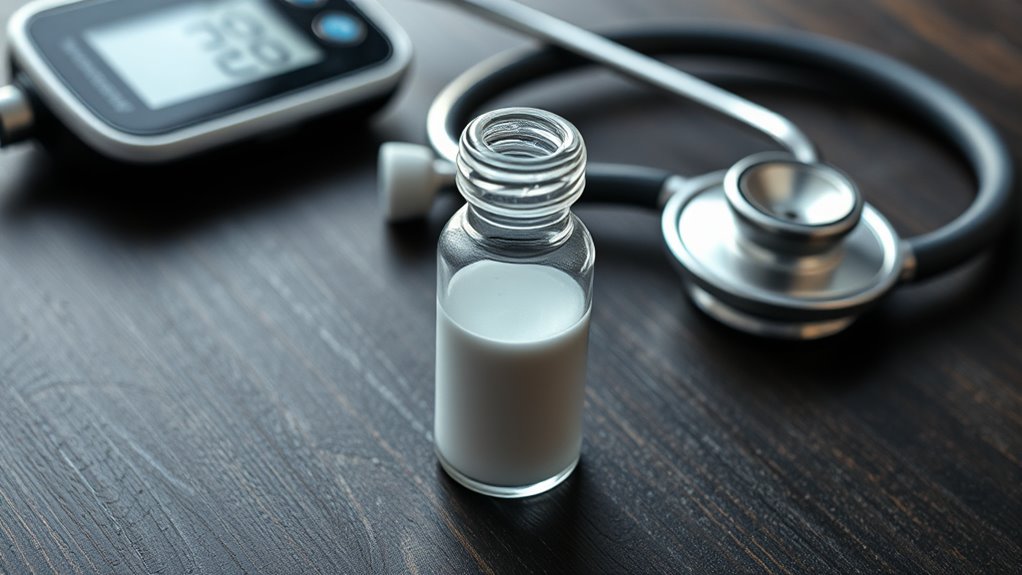Bioidentical hormones are marketed as natural and personalized options for hormone therapy, but their safety isn’t well-proven. Limited research, inconsistent manufacturing, and lack of regulation raise concerns about risks like cancer, blood clots, and heart issues. While some believe they cause fewer side effects, the long-term safety remains uncertain. If you want to understand the true potential and risks, exploring more can help you make informed choices.
Key Takeaways
- Scientific evidence on the safety of bioidentical hormones is limited, and compounded versions lack rigorous testing and regulation.
- Both FDA-approved and compounded bioidentical hormones carry risks such as cancer, blood clots, and cardiovascular issues.
- Compounded bioidenticals can have inconsistent dosing and contamination risks due to unstandardized manufacturing.
- Personalized treatments and claims of increased safety are often unproven and driven by marketing rather than scientific proof.
- Consulting healthcare professionals and relying on evidence-based information are essential for safe hormone therapy decisions.
Understanding Bioidentical Hormones and Their Uses

Have you ever wondered what bioidentical hormones are and how they differ from traditional hormone therapies? These hormones are chemically identical to the ones your body naturally produces, such as estradiol, progesterone, and testosterone. They’re synthesized in labs to match the molecular structure of natural hormones and are often used to balance hormone levels during menopause. You might encounter them in creams, patches, or compounded forms tailored to your specific needs. Bioidentical hormones are commonly employed to reduce menopause symptoms like hot flashes, mood swings, and sleep issues. Many see them as a more natural alternative to synthetic options. Their personalized dosing and delivery methods aim to optimize effectiveness and safety, making them a popular choice in hormone replacement therapy and alternative medicine.
Scientific Evidence and Safety Concerns

Although bioidentical hormones are widely promoted as a natural alternative, scientific evidence supporting their safety and effectiveness remains limited. Compounded bioidentical hormones haven’t been tested in rigorous clinical trials, so their safety and efficacy are uncertain. There’s no proof they’re safer or more effective than FDA-approved options. Risks include inconsistent dosing, contamination, and lack of oversight. The FDA advises against using hormone levels to guide dosing because hormone fluctuations make measurements unreliable. Marketing claims that bioidentical hormones can preserve youth or promote weight loss are unsubstantiated. Additionally, compounded hormones pose risks like contamination and unpredictable effects due to inadequate regulation. High estrogen levels, whether from bioidentical or synthetic hormones, can increase cancer risk, and hormone therapy may raise the chances of blood clots and cardiovascular issues.
Comparing Bioidentical and Synthetic Hormones

When comparing bioidentical and synthetic hormones, the key difference lies in their molecular structures and how these structures influence their interaction with your body’s receptors. Bioidentical hormones match the exact molecular shape of natural hormones, allowing for more natural and effective receptor binding. Synthetic hormones, on the other hand, are chemically altered, which can result in less precise signaling and different physiological effects. This structural difference impacts how your body responds, with bioidenticals often leading to fewer side effects and better regulation. The table below highlights these differences:
| Aspect | Bioidentical Hormones | Synthetic Hormones |
|---|---|---|
| Molecular Structure | Exact match to natural hormones | Chemically altered |
| Receptor Interaction | Natural, effective binding | Less precise, altered response |
| Physiological Effects | Smoother, balanced | Potential for opposite effects |
| Customization & Delivery | Multiple forms, personalized | Limited options, standardized |
Additionally, ongoing research suggests that bioidentical hormones may offer improved safety profiles compared to synthetic options. Some studies also indicate that bioidenticals can be tailored more effectively to individual needs through personalized treatment approaches. Moreover, the regulatory standards for bioidentical hormones can vary, influencing their safety and efficacy. The development of customized therapies is further advancing the potential benefits of bioidentical hormones in personalized medicine.
Potential Risks and Side Effects

You should be aware that bioidentical hormones may increase your risk of certain cancers, like breast or endometrial cancer, especially with long-term use. While they’re often considered safer than synthetic options, concerns about cardiovascular health and blood clots still exist. Additionally, hormone content can vary between products, making it harder to predict your actual risks and side effects. Regular monitoring and consultation with a healthcare professional are crucial to managing these potential risks. Variability in hormone formulations underscores the importance of understanding hormone consistency in products to ensure safety. Recognizing the quality control processes in manufacturing can help mitigate some of these concerns. Being aware of manufacturing standards can further assist in evaluating product safety and reliability. Ensuring adherence to strict regulatory oversight can also reduce the likelihood of inconsistent hormone levels and potential adverse effects.
Cancer Risks Increase
Using bioidentical hormones may carry increased cancer risks, especially if they are not properly regulated or monitored. Although some studies suggest they might pose lower risks than synthetic hormones, concerns remain. Unregulated compounded bioidentical hormones can lead to inconsistent hormone levels, increasing the risk of endometrial cancer, especially if progesterone isn’t used correctly. Hormone therapy has been linked to a higher chance of breast, ovarian, and endometrial cancers, with some evidence pointing to increased blood clot risks too. Large studies like the Women’s Health Initiative highlight these concerns, but data specific to bioidentical hormones are limited. Because regulation varies, your risk depends heavily on quality control and regulation, which directly impacts safety. Additionally, mammography screening is recommended for early detection of breast cancer, which is an important consideration when evaluating hormone therapy risks. It is essential to understand the regulation and quality control of compounded hormones, as this greatly impacts safety. For this reason, standardized manufacturing processes are crucial to ensure consistent hormone levels and reduce potential risks. Furthermore, personalized treatment plans can help mitigate some risks associated with hormone therapy. Always discuss potential cancer risks thoroughly with your healthcare provider before starting bioidentical hormone therapy.
Cardiovascular Uncertainty Remains
Bioidentical hormone replacement therapy (BHRT) may pose cardiovascular risks that are not yet fully understood. These include increased chances of blood clots, stroke, and heart disease, especially with long-term use or in older women. The relationship between BHRT and heart health is complex, influenced by dosage and timing. Clinical studies show mixed results, with some suggesting protective effects, while others highlight potential dangers. To help you visualize, consider this overview:
| Risk Type | Impact | Notes |
|---|---|---|
| Blood Clots | Venous thromboembolism | Can lead to deep vein issues |
| Stroke | Increased risk | Especially in older women |
| Heart Disease | Elevated likelihood | Depends on duration and dose |
| Heart Attack | Possible increase | Linked to age and health factors |
| Overall Uncertainty | Limited conclusive evidence | More research needed |
Remaining questions about safety highlight the importance of careful monitoring and further studies. Additionally, the potential effects on cardiovascular health underscore the need for personalized medical guidance. The complex relationship between hormones and cardiovascular outcomes further emphasizes the importance of professional supervision. A growing body of research suggests that individual factors such as genetics, lifestyle, and heart health can significantly influence these risks. Moreover, vetted information from reputable sources can aid in making informed decisions about hormone therapy.
Hormone Content Variability
How much do you know about the hormone content in bioidentical hormone therapy? Because it varies widely, your treatment’s effectiveness and safety can be unpredictable. Since compounded bioidentical hormones aren’t regulated by the FDA, quality and consistency are concerns. The hormone mixtures often differ from batch to batch, leading to inconsistent effects. You might be receiving different doses of estradiol, progesterone, or testosterone each time. Additionally, dog breeds can have different responses to hormonal therapy based on their genetic makeup.
- Lack of standardization can cause dosage fluctuations.
- Hormone variability increases the risk of side effects like acne or hair growth.
- Inconsistent hormone levels may reduce treatment efficacy.
- Limited long-term safety data leaves uncertainties about potential health risks. Furthermore, quality control issues in compounded formulations can contribute to unpredictable hormone concentrations, making it crucial to choose reputable providers. Implementing testing protocols can help ensure hormone levels remain within safe and effective ranges, providing additional safety measures.
Being aware of potential regulatory gaps can help you advocate for more consistent and safe treatment options.
Regulation and Quality Control Challenges

Regulation and quality control pose considerable challenges for compounded bioidentical hormones because they often operate outside strict oversight by the FDA. Unlike FDA-approved products, compounded hormones aren’t routinely tested or monitored, making it difficult to guarantee safety and consistency. Many compounders don’t follow FDA regulations, and adverse events aren’t always reported, leaving gaps in safety data. Without standardization, hormone levels can vary markedly, risking health issues like blood clots or cancer. Inconsistent formulations and unapproved ingredients, such as DHEA or pregnenolone, further compromise quality. Additionally, compounded hormones lack the rigorous testing that ensures efficacy and safety in approved drugs. This regulatory gap means you may face increased risks, with limited oversight to protect your health. Moreover, the lack of digital literacy programs in some areas can make it harder for consumers to access reliable information about these compounded products.
Short-Term Benefits and Limitations

Are you wondering whether short-term use of bioidentical hormones truly delivers noticeable benefits? Many users do see quick relief from menopausal symptoms, especially hot flashes and vaginal atrophy. You might also notice an improved quality of life, with some studies reporting over a 50% boost after treatment. Additionally, vaginal testosterone and DHEA can enhance arousal, lubrication, and satisfaction. Safety profiles suggest minimal adverse effects on lipid and glucose levels during short-term use.
- Rapid symptom relief, especially for hot flashes and vaginal issues
- Significant improvement in overall quality of life
- No major short-term safety concerns observed
- Variability in dosage and treatment duration across studies
The Need for Long-Term Research Studies

Given the growing interest in bioidentical hormone therapy, the need for long-term research becomes increasingly urgent. Since these hormones aren’t FDA-approved, they haven’t undergone the rigorous safety and effectiveness testing required for approved drugs. Current studies are limited by small sample sizes, variable dosages, and inconsistent formulations, making it hard to draw definitive conclusions. Long-term safety data, especially regarding heart health and cancer risks, are lacking. Without standardized protocols, monitoring side effects and health outcomes remains challenging. Conducting extensive, long-term studies is complex and costly, especially with individualized treatments and limited funding. To ensure safety and efficacy, future research must focus on creating standardized formulations and larger, more detailed studies.
Individualized Treatment: Pros and Cons

Individualized treatment with compounded bioidentical hormones offers the advantage of tailoring dosages and hormone combinations to match each patient’s unique biochemistry. This customization can improve symptom relief, enhance satisfaction, and potentially reduce side effects by adjusting treatments based on your feedback and hormone testing. Personalization helps optimize hormone metabolism and may support overall health. However, there are drawbacks to consider:
Personalized compounded bioidentical hormones may improve symptom relief but come with quality and safety uncertainties.
- Variable quality and consistency in compounded formulations
- Lack of high-quality evidence supporting safety and efficacy
- No proven safety advantage over standard therapies
- Regulatory inconsistencies that can impact treatment reliability
While personalized treatment might seem ideal, it’s essential to weigh these pros and cons with your healthcare provider to ensure safe and effective hormone management.
Future Directions in Hormone Therapy Research

The future of hormone therapy research is shaped by rapid advancements that promise to transform treatment options. Market growth, with a projected CAGR of 6.3%, indicates increasing investment and innovation. Personalization through genetic testing allows you to receive hormone therapies tailored specifically to your genetic makeup, reducing side effects and improving effectiveness. Telemedicine is expanding access, making consultations more convenient. New formulations and delivery systems are being developed to enhance absorption, efficacy, and safety, while biotechnology innovations aim to improve hormone production. Supportive regulations further integrate bioidentical hormones into mainstream healthcare. These advancements collectively point toward more precise, effective, and personalized treatments, ultimately empowering you to make better-informed decisions and experience improved health outcomes in hormone therapy.
Making Informed Decisions About Hormone Treatments

When considering hormone treatments, it’s essential to evaluate the scientific evidence behind their safety and effectiveness. You also need to understand the regulatory gaps, especially around compounded bioidentical hormones that lack FDA approval. Making informed decisions means weighing the benefits against potential risks and consulting with healthcare providers about your options.
Evaluating Scientific Evidence
Evaluating the scientific evidence behind bioidentical hormones is essential for making informed decisions about their use. Currently, there’s no solid proof that these hormones are safer than traditional therapies. Compounded bioidentical hormones pose risks like inconsistent dosing and potential contamination. Many claims about their ability to maintain youth or promote weight loss lack scientific support. FDA-approved bioidentical hormones carry risks similar to synthetic options, including increased chances of breast and uterine cancers, strokes, and blood clots. Blood tests are unreliable for guiding dosing, and there’s no standardized approach. Remember, claims of personalized treatment are unproven. To make safe choices, rely on scientific evidence rather than marketing hype, and consult healthcare professionals for guidance.
Understanding Regulatory Gaps
Understanding the regulatory landscape for bioidentical hormones is essential for making informed treatment decisions. While FDA-approved bioidentical hormones come in standardized doses and formulations, compounded versions aren’t FDA approved due to lack of standardization and review. The FDA doesn’t prohibit compounding but doesn’t approve these products either, creating a regulatory gap. Both types may contain identical hormones, but compounded hormones lack safety data, labeling requirements, and adverse event reporting. This limits oversight, making it harder to monitor quality and safety. State and federal agencies share responsibility, but enforcement is inconsistent. Without rigorous regulation, compounded hormones pose potential risks, including contamination or mislabeling. Knowing these gaps helps you weigh the safety and efficacy of different hormone treatments more carefully.
Frequently Asked Questions
How Do Bioidentical Hormones Differ Chemically From Synthetic Hormones?
You might wonder how bioidentical hormones differ chemically from synthetic hormones. Bioidentical hormones have the exact molecular structure of natural hormones, often derived from plants and processed to match human hormones. Synthetic hormones, on the other hand, have slightly different molecular structures, created entirely in labs. This structural difference impacts how they interact with your body, influencing their physiological effects and potential side effects.
Are Compounded Bioidentical Hormones Regulated by Government Agencies?
You wonder if compounded bioidentical hormones are controlled by the government. While regulations exist, they’re limited—federal oversight is weak, and registration isn’t required for compounding pharmacies. The FDA can enforce standards, but enforcement is inconsistent. You should know that the lack of strict regulation means safety and efficacy aren’t guaranteed. It’s wise to weigh the risks, seek FDA-approved options, and stay informed about the regulatory landscape to protect your health.
What Are the Long-Term Health Risks of Using Bioidentical Hormones?
Long-term use of bioidentical hormones can pose significant health risks. You might face increased chances of breast cancer, heart disease, and blood clots. Prolonged use can also lead to gallbladder problems and possibly raise your risk of dementia. Since many formulations lack regulation and consistent dosing, these risks could be amplified. It is crucial to weigh these concerns carefully and consult your healthcare provider before committing to long-term hormone therapy.
Can Blood Hormone Levels Reliably Guide Personalized Hormone Therapy?
Like trying to catch smoke with your hands, relying solely on blood hormone levels to guide therapy isn’t foolproof. You might get some clues, but they’re often unreliable due to natural fluctuations and testing limitations. Instead, you should work closely with your healthcare provider, combining lab results with your symptoms and health history. This personalized approach guarantees safer, more effective treatment tailored to your unique needs.
What Evidence Supports the Safety of Bioidentical Hormone Therapy?
You’re wondering what evidence supports bioidentical hormone therapy’s safety. The truth is, high-quality research is limited. Most studies are small or observational, and no systematic reviews confirm safety. Risks like cancer, blood clots, and cardiovascular issues have been noted, but without rigorous trials or FDA approval, these findings remain inconclusive. Thus, you should approach bioidentical hormones cautiously, understanding the current lack of definitive safety evidence.
Conclusion
Steering bioidentical hormones is like steering a ship through foggy waters—you need a clear map and trusted compass. While promising, their safety isn’t fully charted, and risks may lurk unseen. Stay informed, ask questions, and consult with healthcare guides who can navigate these uncharted seas with you. Only then can you find a safe harbor in your hormone journey, balancing hope with caution on this complex voyage.









